Key Takeaways: What Are the Best Note-Taking Apps for Android?
- Microsoft OneNote — The best all-around note-taking app for Android
- Google Keep — The best minimalist note-taking app for Google users
- Evernote — A feature-rich note-taking app with advanced functionalities
- Obsidian — A networked note-taking app for thinkers
- Bundled Notes — A user-friendly, Android-first note-taking app
A note-taking app is an essential tool that everyone should have on their phone. You never know when you’ll have a brilliant idea or need to quickly jot down important information. That’s why we have curated a selection of the best note-taking apps for Android.
Our list includes apps ranging from simple replacements for your sticky notes to feature-rich options with advanced functionalities.
Microsoft OneNote is the best free note-taking app, with a comprehensive set of features for taking notes. If you prefer a more advanced note-taking experience, Evernote is an excellent choice. Keep reading to explore more of the best note-taking apps for Android.
Cloudwards Editor’s Choice: Microsoft OneNote
After testing many Android note-taking apps on the market, we found that Microsoft OneNote is the best overall pick. It offers the perfect balance between simplicity and functionality. We like how flexible it is for capturing and structuring information. It lets you create notes in various formats and organize them the way you like.
You can also use OneNote for a wide range of purposes, such as personal journals, team wikis and project management. This makes it suitable for students, professionals and anyone who wants to stay organized. Additionally, OneNote’s integration with other Microsoft applications makes it an even more powerful tool.
How to Choose the Best Notes App for Android
With a variety of notes apps available, you may find yourself wondering which one is the best fit for you. Here are some key features to consider when selecting a note-taking app:
- Ease of use: Look for a note-taking app that has a clean and intuitive interface so you can quickly jot down your thoughts without any friction.
- Organizational tools: Features like tags, folders and search functionality are important for keeping your notes organized and easily accessible.
- Syncing capabilities: Choose an Android app that allows you to sync your notes across multiple devices so you can access them wherever you go.
- Affordable price: Good note-taking apps should have a free version or at least a low price to make them accessible.
- Integrations: Consider using a note-taking app that integrates with other productivity apps you use, such as calendars or task managers.
- Security and privacy: A notes app should have strong security measures, such as encryption or password protection, to ensure the privacy of your notes.
1. Microsoft OneNote
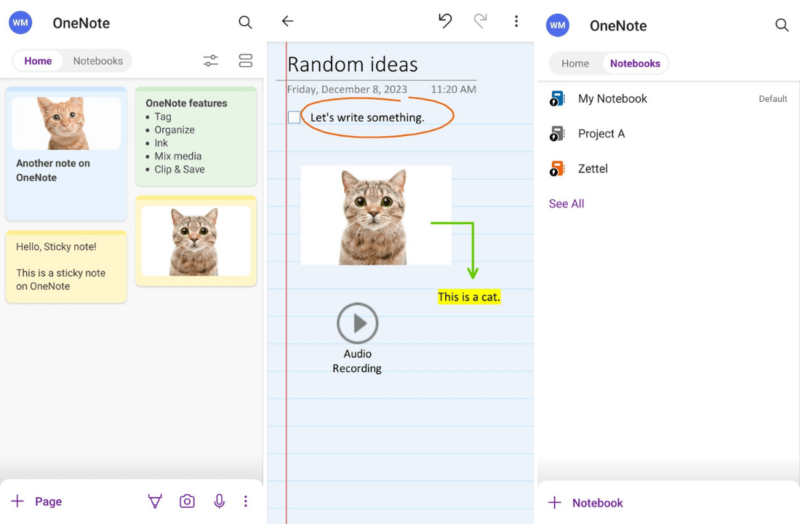
More details about Microsoft OneNote:
- Pricing: Free, $5.83 per month for Microsoft 365 Personal (one-year plan)
- Website: onenote.com
Pros:
- User-friendly interface
- Great free version
- Integrated Microsoft apps
Cons:
- Not end-to-end encrypted
- Lacks markdown without plugins
Microsoft OneNote offers a comprehensive note-taking solution with a strong focus on organization. It allows you to create different types of notes, including sticky notes, plain text notes, voice notes and handwritten notes.
OneNote gives you the freedom to click anywhere on a note and add images, ink (handwriting) and to-do list tags. You can also scan documents and insert them directly into your notes.
Plus, you can easily organize notes with notebooks, sections and pages and access notes from any device. The search function is also available for finding specific information within your notes.
OneNote, as part of the Microsoft 365 suite, integrates with other Microsoft products, such as Word and Outlook. This makes it convenient for users already in the Microsoft ecosystem. You can also integrate OneNote with other apps through Zapier or IFTTT. Moreover, OneNote allows you to create locked notes by applying password protection to specific sections.
Microsoft OneNote Hands-on Testing
Microsoft OneNote’s interface is intuitive, and navigating through notebooks, sections and pages is smooth. However, like other Microsoft apps, OneNote’s design has a corporate feel. Some users have mentioned in online communities that OneNote sometimes experiences lags and delays when syncing changes across devices.
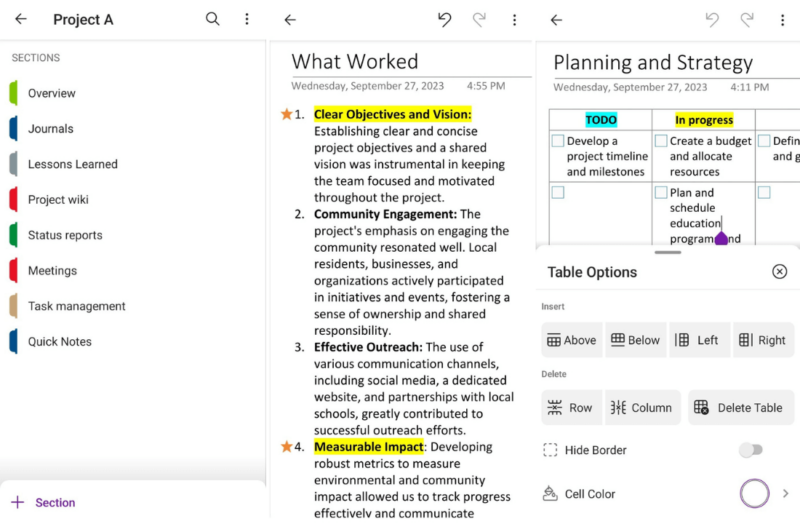
Microsoft OneNote Pricing & Value
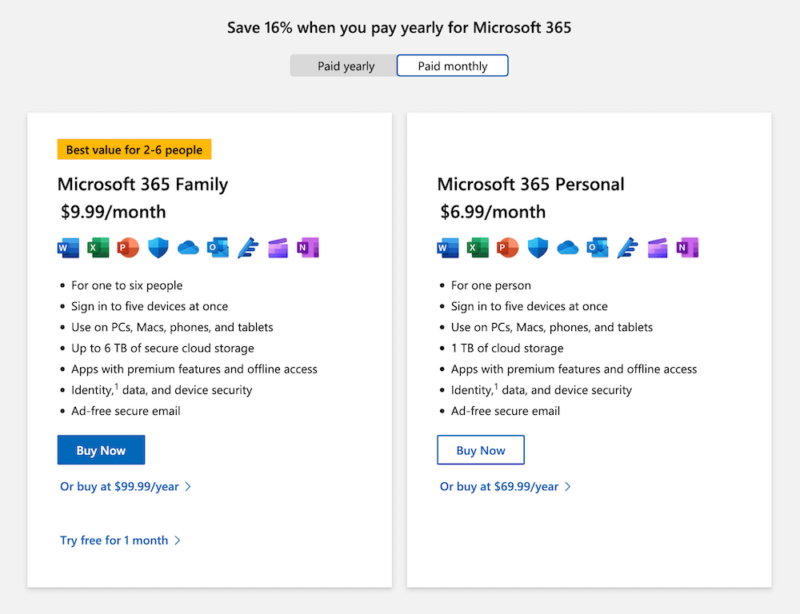
Microsoft OneNote offers a great free version with all the basic features that most users will need plus 5GB of storage space on OneDrive. If you need more advanced features and additional storage, you have to sign up for a Microsoft 365 subscription.
Microsoft 365 offers the Basic plan for $1.99 per month. There is also a Microsoft 365 Personal plan for one user, starting at $6.99 per month, and a Family plan for up to six people, starting at $9.99 per month. It also has three business plans to choose from.
OneNote is available to download through the Google Play Store. Check out our OneNote review for more information about its features and pricing.
2. Google Keep
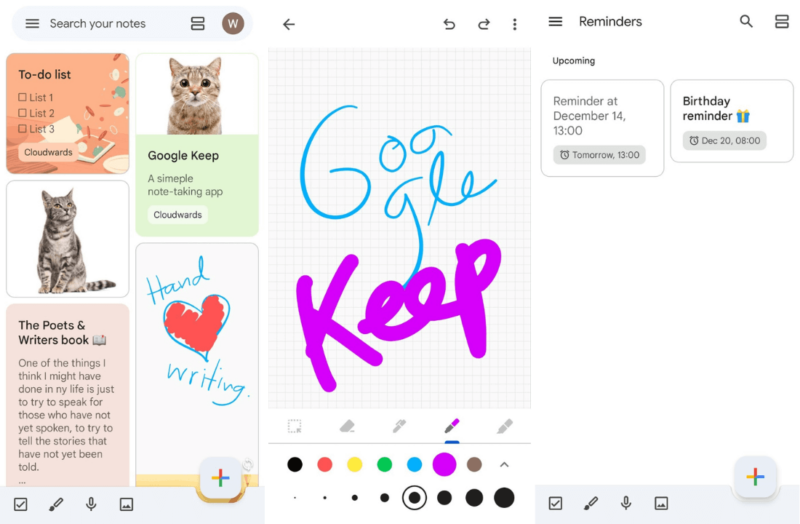
and minimalist app for a quick note.
More details about Google Keep:
- Pricing: Free
- Website: keep.google.com
Pros:
- Free to use
- Fully Google integrated
- Supports many media types
Cons:
- Lacks organizational features
- Limited formatting options
Google Keep is one of the most straightforward free note-taking apps. Keep is perfect for taking quick notes and making to-do lists. Most Android devices have it pre-installed, much like iOS with Apple Notes.
Keep offers decent note-taking capabilities. You can create text notes, checklists, handwritten notes and reminders with just a tap. You can also add images and voice recordings. The app supports labels for arranging notes, but it lacks folders and other organizational features.
What sets Google Keep apart is its seamless integration with other Google apps, such as Google Calendar and Google Docs. Furthermore, the app uses encryption both during transit and at rest. If you opt to access your notes offline, Google Keep will store them in the Android app.
Google Keep Hands-on Testing
Google Keep has a Post-it-like minimalist design, and there is no learning curve. However, the absence of folders can make it difficult to manage and locate notes.
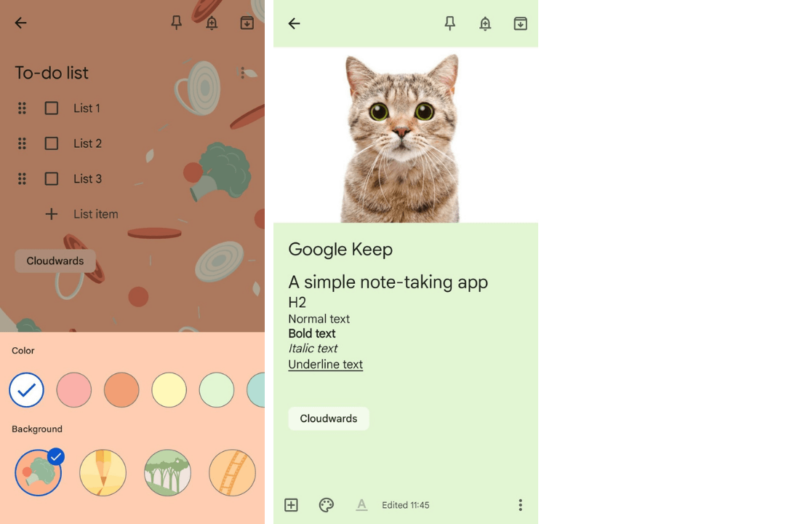
Google Keep Pricing & Value
The best part about Google Keep is that it is completely free to use. You can create as many notes as you want and access them from any device for free. Overall, Google Keep is a great note-taking app for Google users who want to easily take notes while on the go. Read more about it in our Google Keep review.
3. Evernote
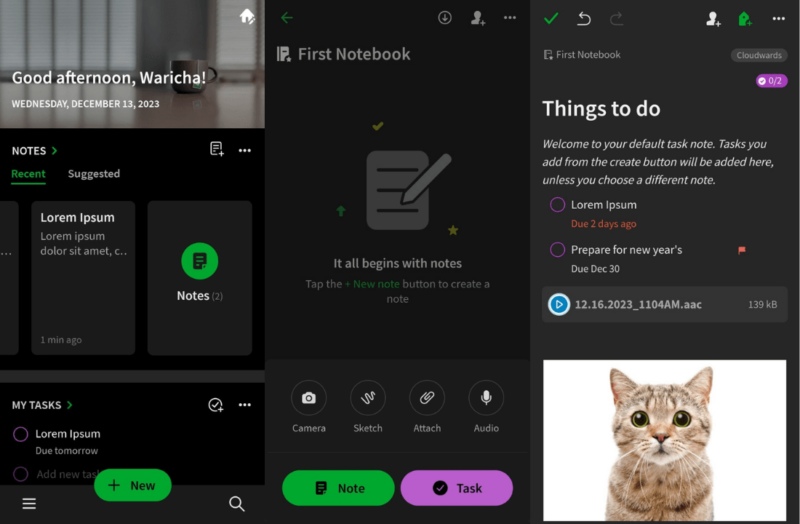
More details about Evernote:
- Pricing: $10.83 per month (one-year plan)
- Website: evernote.com
Pros:
- Extensive note-taking
- Integration with many apps
- Good for collaboration
Cons:
- Slow load times
- Occasional glitches
- Expensive paid plans
Evernote is a popular note-taking app with an extensive range of features. You can create various types of notes, including basic text notes, audio notes, meeting notes and to-do lists. It also has stylus support for those who prefer to handwrite their notes. Another useful feature is the ability to attach files and send emails directly to the app.
Organizing notes with tags and notebooks is simple. Its efficient search functionality also helps users quickly find specific notes. You can share notes with others and even collaborate on them in real time. Moreover, Evernote syncs across devices, making all your notes accessible everywhere.
Evernote integrates with numerous third-party apps. To secure user data, it uses TLS or IPSEC with GCM-AES-128 encryption while in transit and AES-256 encryption while at rest.
Evernote Hands-on Testing
Despite its extensive feature set, Evernote’s interface is well organized and intuitive. You can customize your homepage with widgets to show recent notes or important notes. We also like that it offers many templates, such as project plans and meeting notes. However, we found the app to be slow and lag at times compared to other Android apps.
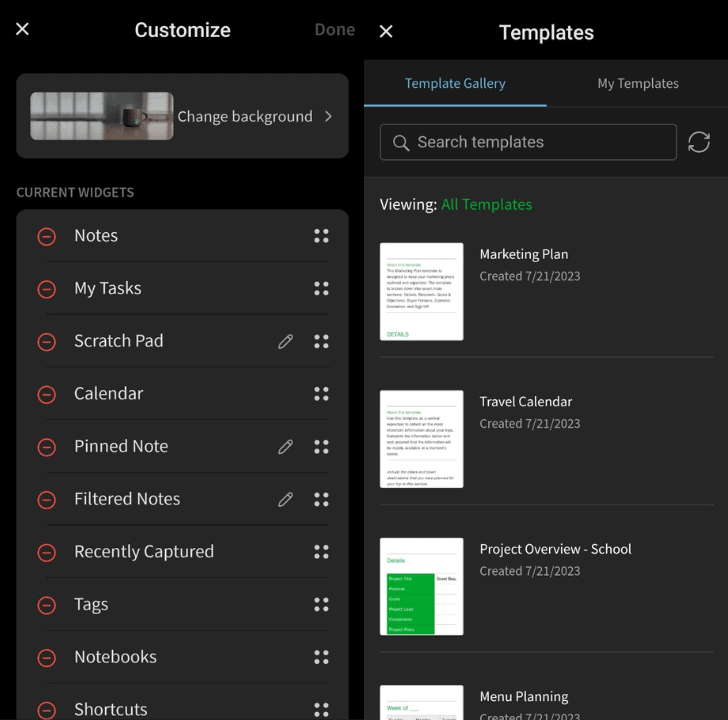
Evernote Pricing & Value
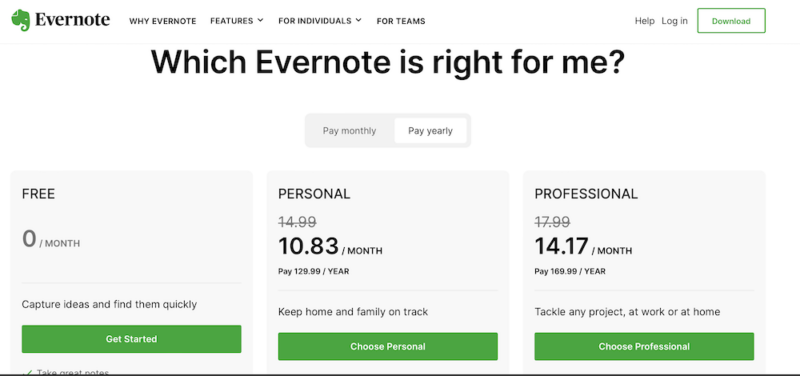
There is an Evernote free plan, but it’s quite limited — especially with the latest update. Unlike OneNote, most of Evernote’s features are available only on paid plans. Pricing starts at $10.83 per month for the Personal plan and goes up to $14.17 per month for the Professional plan.
The prices are higher than those of other note-taking apps. However, for those who rely heavily on note-taking and organization, Evernote’s rich features may justify its higher price.
That being said, we have seen a higher rate of negative reviews about Evernote’s performance and pricing in user communities and on our website. We recommend you try its seven-day free trial to decide whether it’s worth the investment. Give our Evernote review a read for more details.
- 2 devices, 60MB
- Unlimited devices, 10GB
- Unlimited devices, 20GB
- Unlimited devices, 20GB + 2 GB per user
4. Obsidian
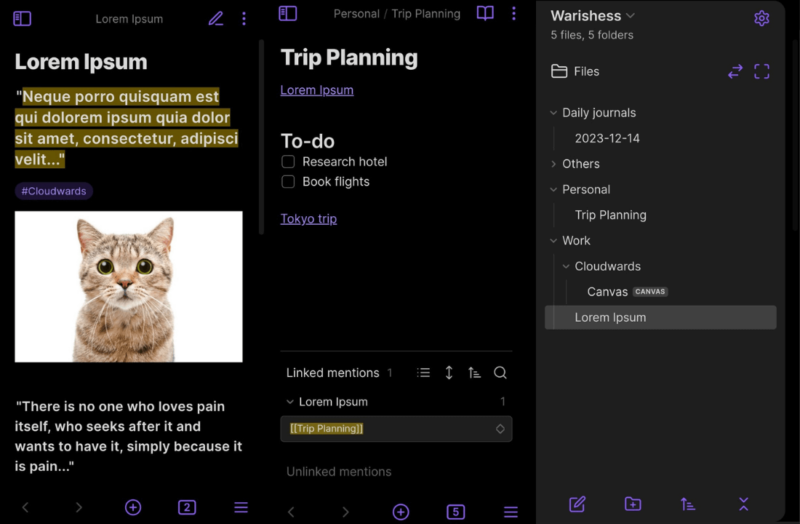
More details about Obsidian:
- Pricing: Free for personal use
- Website: obsidian.md
Pros:
- Local-first app
- Highly customizable
- Great visual representation
Cons:
- Steep learning curve
- Pay to sync notes across devices
For many people, a note-taking app is more than just a tool for jotting down ideas; it’s also for connecting thoughts and expanding knowledge. Obsidian is one of the best apps for that purpose. It allows you to create basic notes and link them using backlinks, forming a network of knowledge.
Obsidian offers many useful features, such as markdown support, graph and canvas views and powerful search options. You can sort your material notes into folders and sub-folders and customize your own theme.
Additionally, Obsidian is a local-first app, which means that your notes are stored on your device. This provides security and control over your data. However, if you want to sync your notes between multiple devices, you will need to pay for an add-on.
Obsidian Hands-on Testing
Obsidian provides a unique note-taking experience compared to other note-taking apps. However, this comes with a steeper learning curve. We found that using markdown to format notes is very smooth. The graph view in Obsidian is also a standout feature for visualizing connections between ideas.
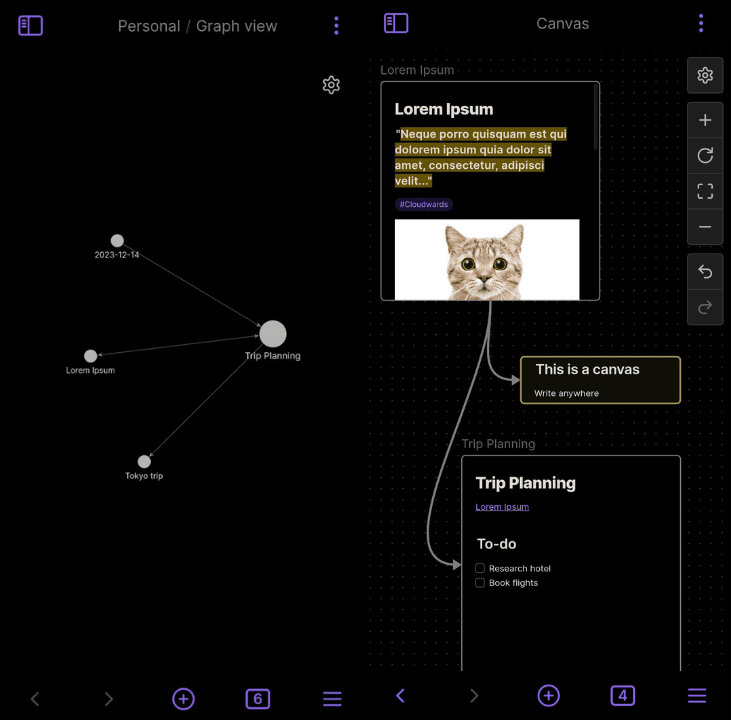
Obsidian Pricing & Value
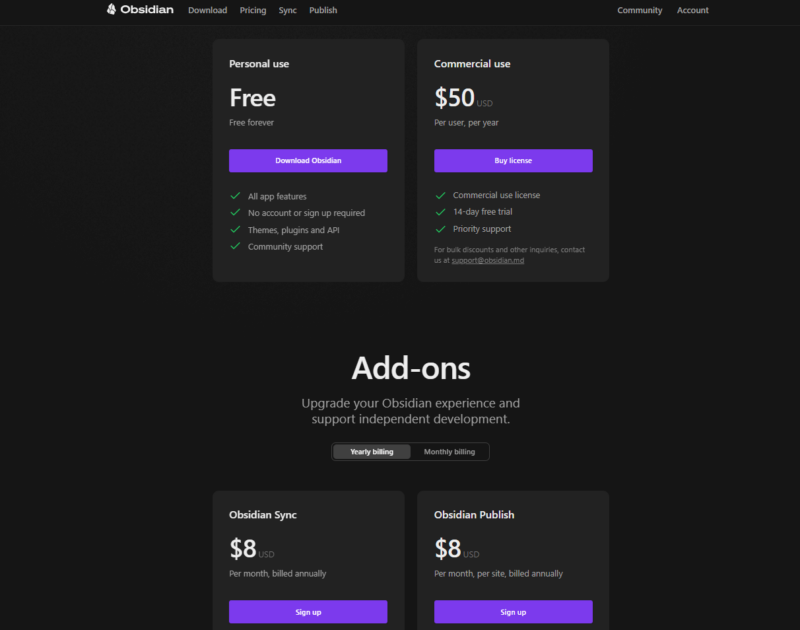
for note-taking and organization.
Obsidian is free for personal use, while the commercial use license costs $50 per user per year. You also have to pay for certain additional features. For example, the “Obsidian publish” add-on will publish your notes on web pages for $8 per site per month, billed annually.
With its consistent updates and active community support, Obsidian could be a go-to tool for anyone looking for a unique approach to taking notes. Read more about the app in our Obsidian review.
- Only local storage
- Required for businesses
- 10GB cloud storage
More plans
- Web-hosting for Wikis
- Beta versions of Obsidian and VIP badges
5. Bundled Notes
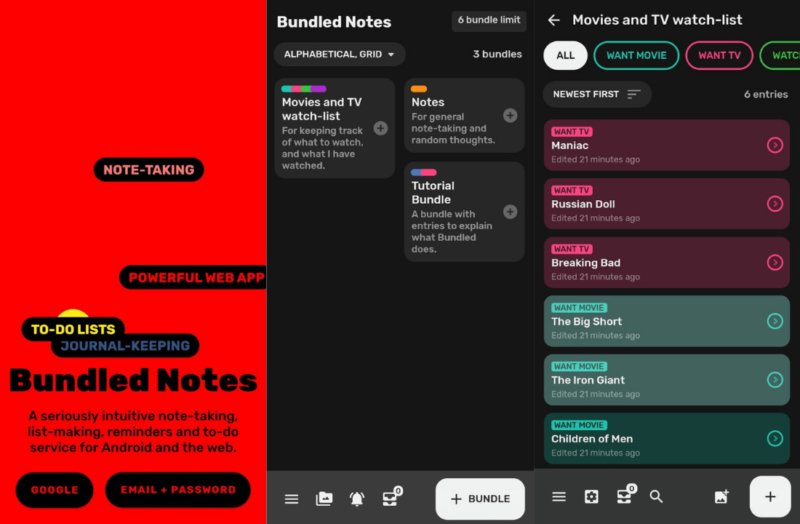
More details about Bundled Notes:
- Pricing: Free, $1.89 per month for Pro plan
- Website: bundlednotes.com
Pros:
- Modern, intuitive design
- Supports kanban boards
- Rich markdown text editor
Cons:
- Upgrade to Pro to sync notes on a web app
- Security features are being planned
If you’re looking for a simple note-taking app that is also fun to use, Bundled Notes is a solid choice. As its name suggests, this app offers a “bundle” feature that lets you organize your notes just like with notebooks or folders in other apps.
You can create a note, a to-do list or a reminder and customize the look and feel to your preference. Moreover, you can use tags on your notes and turn them into kanban boards.
Bundled Notes can synchronize across tablets and Chromebooks, but you will need to upgrade to the Pro plan to access your notes on the web app. Note that most of its security features, like two-factor authentication and end-to-end encryption, are still planned.
Bundled Notes Hands-on Testing
Bundled Notes has the most delightful interface to use of all the apps on this list. The app offers many options for customizing the layout and design of your notes. You can also use markdown to format your notes. Though its features are not as extensive as those of some other apps, Bundled Notes delivers an impressive user experience.
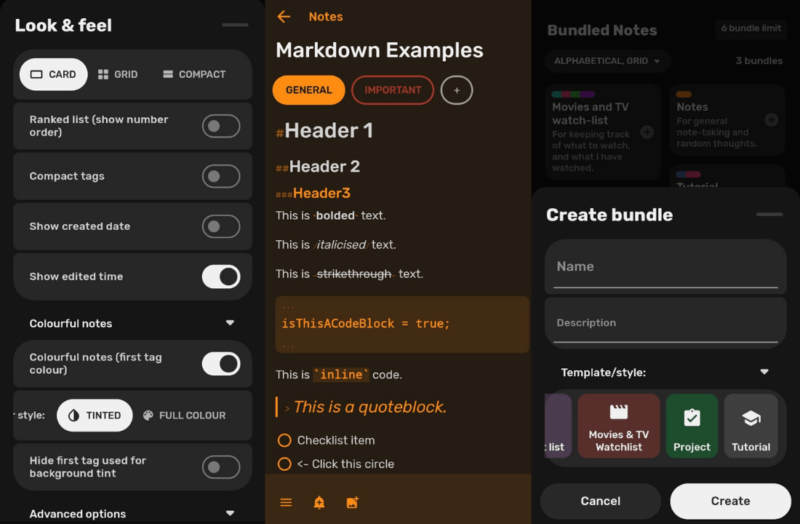
options enhance the overall user experience.
Bundled Notes Pricing & Value
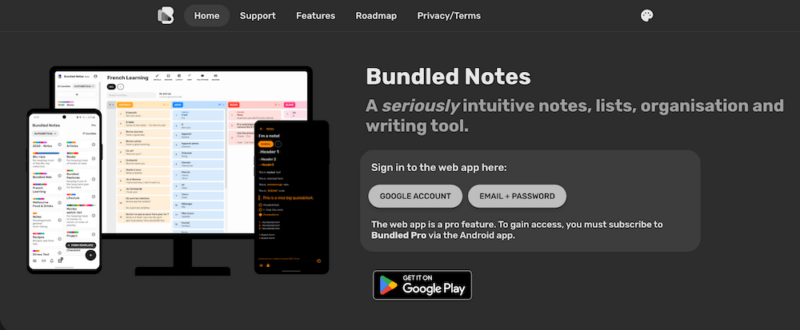
Pro plan adds more features and web app access.
Bundled Notes is available for free in the Google Play Store. The free plan allows users to create up to six bundles. In-app purchases are available with the Pro plan for $1.89 per month (price may vary by region). Additional features include 15GB of account storage, the ability to upload files of up to 400MB each and unlimited bundles and notes.
| Plan: | Price (Monthly) | Price (Yearly) |
|---|---|---|
| Free | Free | Free |
| Pro | $1.89 per month | $18 annually |
How to Use Android Note-Taking Apps
We’ll show you the steps to create and organize notes in Microsoft OneNote.
- Create a New Page
On the home screen of the OneNote app, tap the “+ page” button to create a new note.
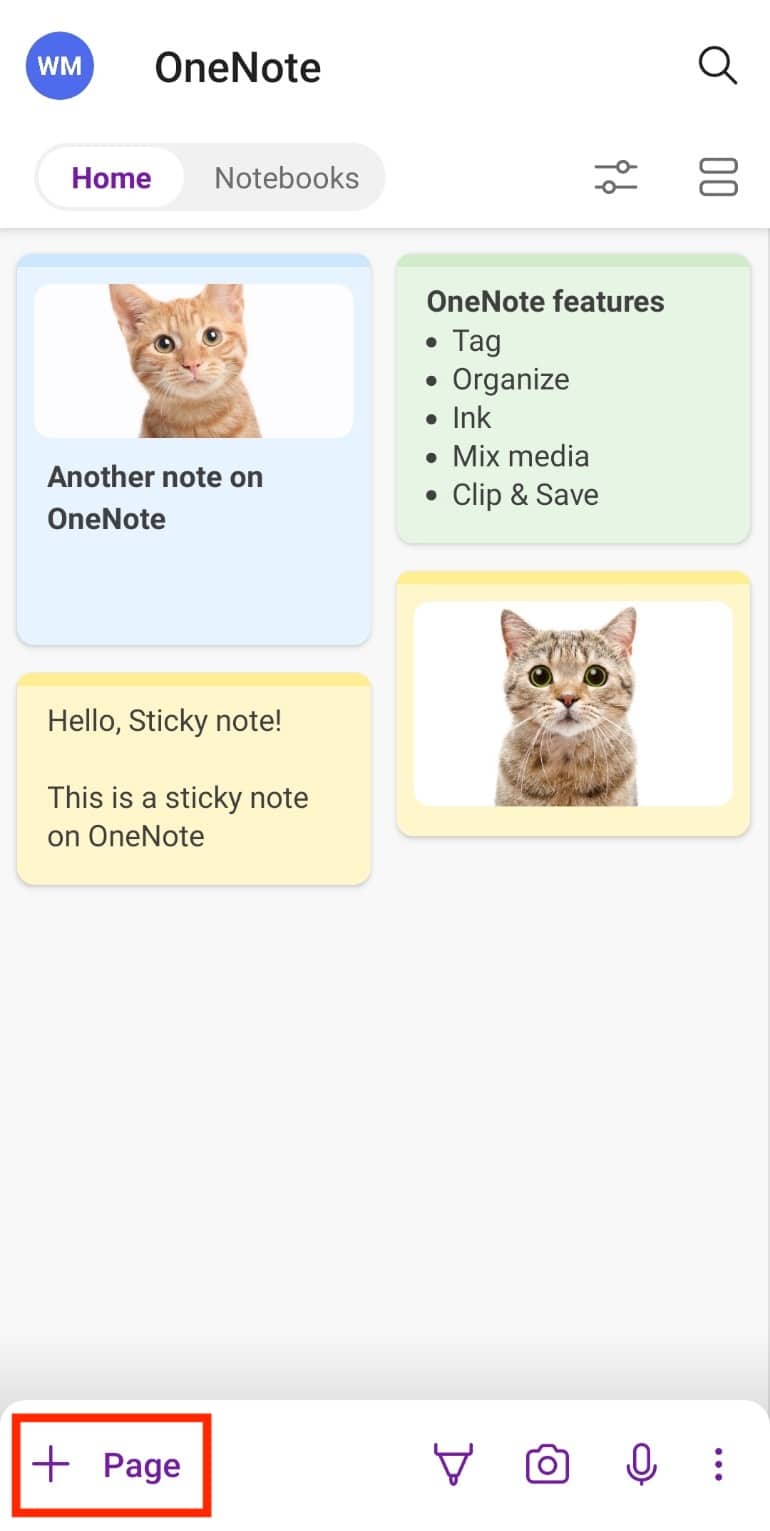
- Add a Title and Content
Tap the top of the page to add a title for your note. Then, click anywhere in the note’s body to write your content. To format the text, highlight the text and use the formatting options at the bottom of the screen. You can change the font, size, style and color of your text.
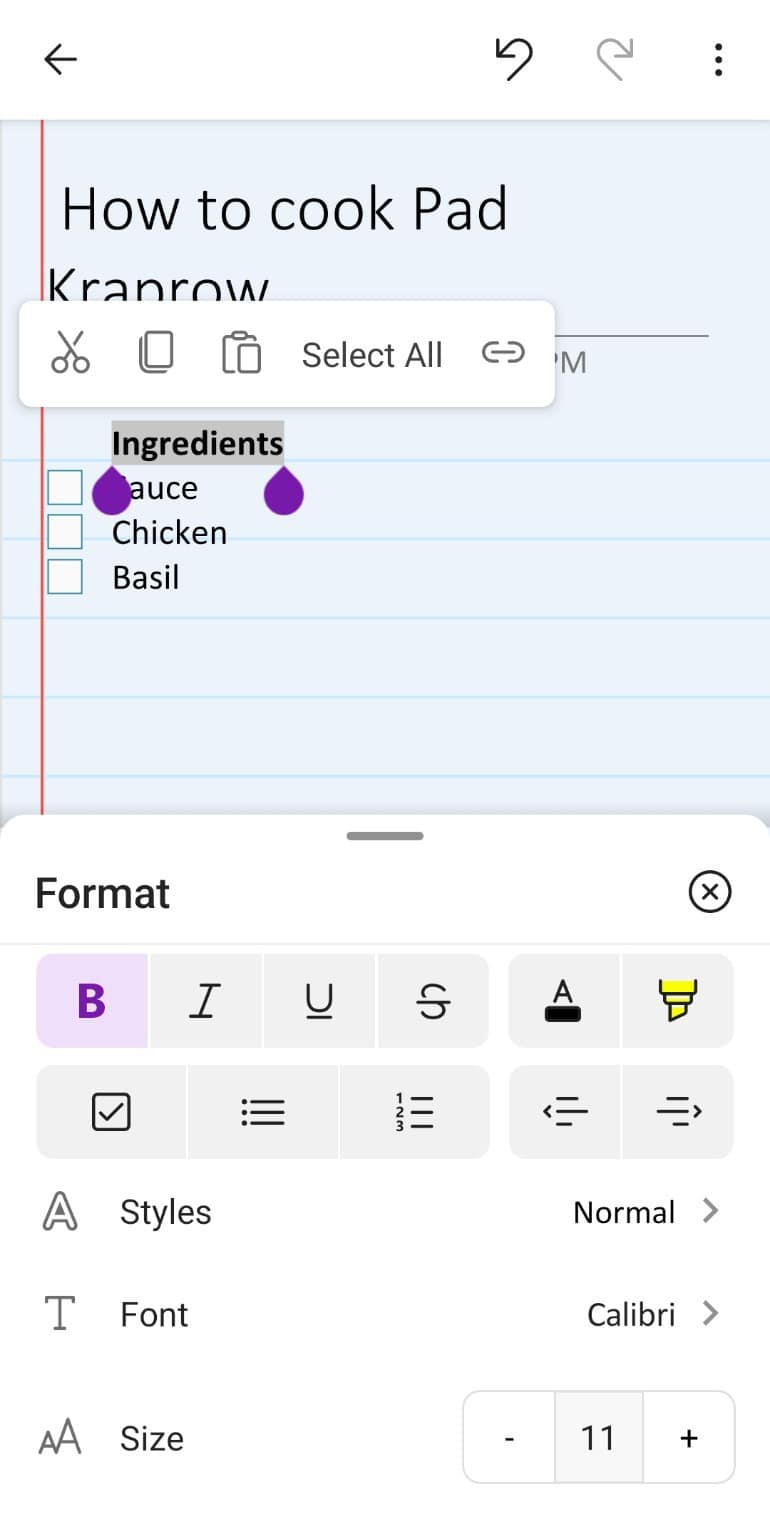
- Add Media to Your Note
You can add material notes by tapping the “+” button at the bottom left of the screen. Choose the type of media you want to insert: images, drawings, audio recordings, files, links or tables.
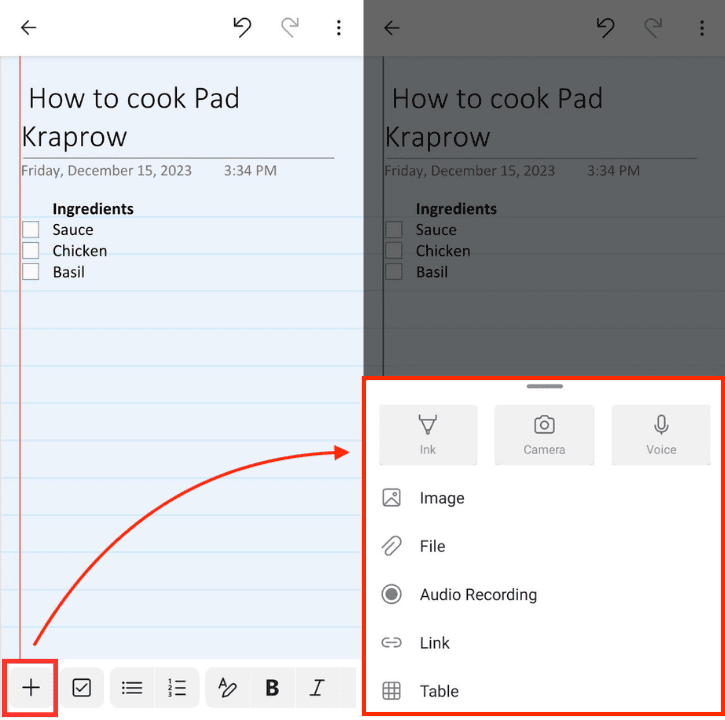
- Organize Your Notes
Tap the three-dot icon in the top-right corner and select the section and notebook where you want to keep your notes.
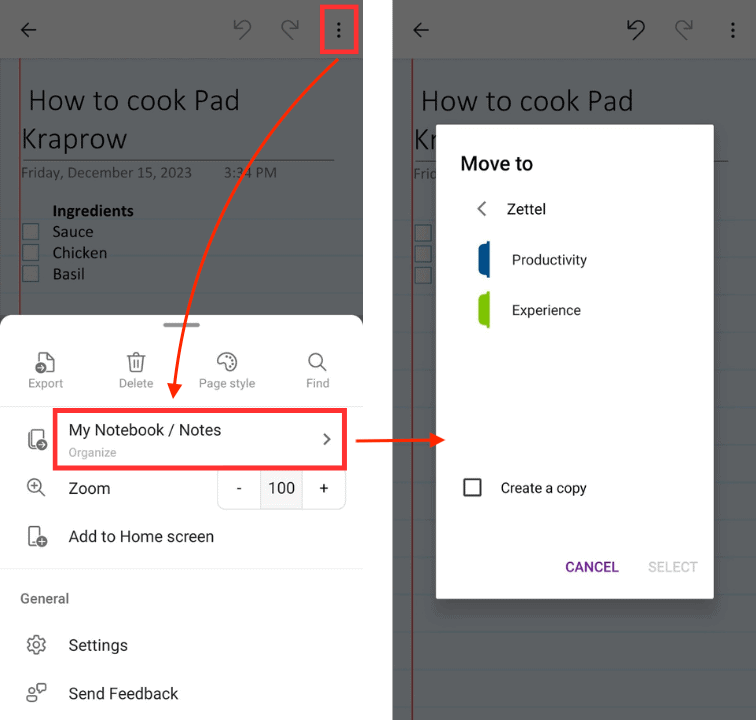
{“@context”:”https:\/\/schema.org”,”@type”:”HowTo”,”name”:”How to Use Android Note-Taking Apps”,”description”:”These step-by-step instructions show how to use Android note-taking apps.”,”totalTime”:”P00D02M00S”,”supply”:0,”tool”:0,”url”:”https:\/\/www.cloudwards.net\/note-taking-apps-for-android\/#how-to-use-android-note-taking-apps”,”image”:{“@type”:”ImageObject”,”inLanguage”:”en-US”,”url”:”https:\/\/www.cloudwards.net\/wp-content\/uploads\/2024\/01\/Best-Note-Taking-Apps-for-Android.png”},”step”:[{“@type”:”HowToStep”,”name”:”Create a New Page”,”position”:1,”url”:”https:\/\/www.cloudwards.net\/note-taking-apps-for-android\/#create-a-new-page”,”itemListElement”:{“@type”:”HowToDirection”,”text”:”On the home screen of the OneNote app, tap the “+ page” button to create a new note.\n”},”image”:{“@type”:”ImageObject”,”inLanguage”:”en-US”,”url”:”https:\/\/www.cloudwards.net\/wp-content\/uploads\/2024\/01\/step1-onenote-new-page.jpg”}},{“@type”:”HowToStep”,”name”:”Add a Title and Content”,”position”:2,”url”:”https:\/\/www.cloudwards.net\/note-taking-apps-for-android\/#add-a-title-and-content”,”itemListElement”:{“@type”:”HowToDirection”,”text”:”Tap the top of the page to add a title for your note. Then, click anywhere in the note’s body to write your content. To format the text, highlight the text and use the formatting options at the bottom of the screen. You can change the font, size, style and color of your text.\n”},”image”:{“@type”:”ImageObject”,”inLanguage”:”en-US”,”url”:”https:\/\/www.cloudwards.net\/wp-content\/uploads\/2024\/01\/step2-onenote-add-content.jpg”}},{“@type”:”HowToStep”,”name”:”Add Media to Your Note”,”position”:3,”url”:”https:\/\/www.cloudwards.net\/note-taking-apps-for-android\/#add-media-to-your-note”,”itemListElement”:{“@type”:”HowToDirection”,”text”:”You can add material notes by tapping the “+” button at the bottom left of the screen. Choose the type of media you want to insert: images, drawings, audio recordings, files, links or tables.\n”},”image”:{“@type”:”ImageObject”,”inLanguage”:”en-US”,”url”:”https:\/\/www.cloudwards.net\/wp-content\/uploads\/2024\/01\/step3-onenote-add-media.png”}},{“@type”:”HowToStep”,”name”:”Organize Your Notes”,”position”:4,”url”:”https:\/\/www.cloudwards.net\/note-taking-apps-for-android\/#organize-your-notes”,”itemListElement”:{“@type”:”HowToDirection”,”text”:”Tap the three-dot icon in the top-right corner and select the section and notebook where you want to keep your notes.\n”},”image”:{“@type”:”ImageObject”,”inLanguage”:”en-US”,”url”:”https:\/\/www.cloudwards.net\/wp-content\/uploads\/2024\/01\/step4-onenote-organize.png”}}]}
Final Thoughts: Android Note-Taking Apps
Every note-taking app has the same core functionality: to capture notes and organize them, freeing your mind from having to remember everything. However, the differences between apps are in their use cases and unique features.
The best overall notes app for Android is OneNote, while Evernote is best suited for professionals who need more advanced features.
Google Keep and Bundled Notes are lightweight and straightforward apps for quick note-taking. For thinkers or those who want to connect their ideas and create a web of knowledge, Obsidian is an excellent choice.
What is your favorite note-taking app and why? Have you tried any of the best note-taking apps for Android mentioned above? Which features in a note-taking app do you find most useful? Let us know your thoughts in the comments below. Thank you for reading!
FAQ: Notes Apps for Android
-
Microsoft OneNote tops the list for the best note-taking apps for Android. It allows you to create unlimited notes in different formats, such as text, audio and handwriting. You can also share notes and collaborate with others. Moreover, OneNote syncs across devices and integrates with other Microsoft apps.
-
Yes, there are several free notes apps available for Android. Some popular note-taking apps include OneNote and Google Keep. These apps offer basic note-taking features and allow you to organize and access your notes easily.
-
Notes apps typically allow you to type your notes directly on your phone. Many apps, like OneNote and Evernote, offer the ability to sketch notes using a stylus or your finger on the touchscreen. Additionally, you can use the voice-to-text feature on your Android phone to transcribe audio notes into written text.
-
Yes, Evernote offers a wide range of features that make it worth considering. Evernote allows you to create notes and notebooks, add tags and sync your notes across devices. It also offers the ability to collaborate with others. However, there have been complaints about Evernote’s price and performance.
{“@context”:”https:\/\/schema.org”,”@type”:”FAQPage”,”mainEntity”:[{“@type”:”Question”,”name”:”Which Notes App Is Best for Android?”,”acceptedAnswer”:{“@type”:”Answer”,”text”:”
Microsoft OneNote tops the list for the best note-taking apps for Android. It allows you to create unlimited notes in different formats, such as text, audio and handwriting. You can also share notes and collaborate with others. Moreover, OneNote syncs across devices and integrates with other Microsoft apps.\n”}},{“@type”:”Question”,”name”:”Is There a Free Notes App for Android?”,”acceptedAnswer”:{“@type”:”Answer”,”text”:”
Yes, there are several free notes apps available for Android. Some popular note-taking apps include OneNote and Google Keep. These apps offer basic note-taking features and allow you to organize and access your notes easily.\n”}},{“@type”:”Question”,”name”:”How Do You Write Notes on an Android Phone?”,”acceptedAnswer”:{“@type”:”Answer”,”text”:”
Notes apps typically allow you to type your notes directly on your phone. Many apps, like OneNote and Evernote, offer the ability to sketch notes using a stylus or your finger on the touchscreen. Additionally, you can use the voice-to-text feature on your Android phone to transcribe audio notes into written text.\n”}},{“@type”:”Question”,”name”:”Is Evernote Still Worth it?”,”acceptedAnswer”:{“@type”:”Answer”,”text”:”
Yes, Evernote offers a wide range of features that make it worth considering. Evernote allows you to create notes and notebooks, add tags and sync your notes across devices. It also offers the ability to collaborate with others. However, there have been complaints about Evernote’s price and performance.\n”}}]}
The post The Best Note-Taking Apps for Android in 2024: Paid & Free Note-Taking Apps for Mobile appeared first on Cloudwards.


